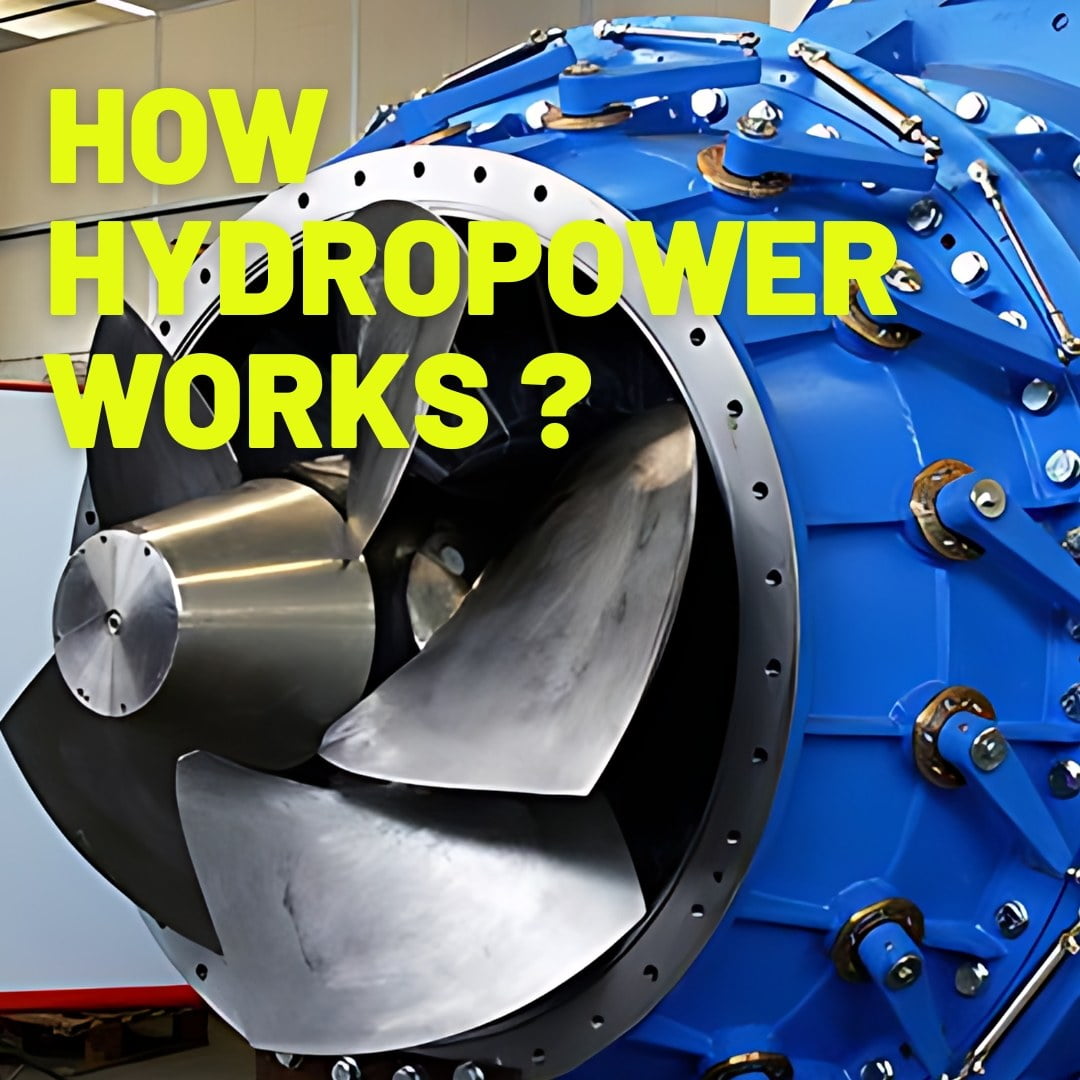August 14, 2024 By Amber raza 6 minutes read

Impact-Site-Verification: 40cf13f8-deac-49a1-b73a-9b8a75138f16
Hydropower, also known as water power, is one of the oldest and most reliable forms of renewable energy. It harnesses the natural movement of water, whether from rivers, dams, or ocean tides, to generate electricity.
The basic idea is simple: water flows through turbines, which spin and convert that motion into energy. This energy is then transformed into electricity and supplied to homes, businesses, and industries.
Hydropower plays a vital role in today’s energy mix, contributing nearly 16% of global electricity generation. Not only is it a clean and renewable source of energy, but it’s also highly efficient.
For every unit of energy put into hydropower systems, nearly 90% can be converted into usable electricity. This makes it far more efficient than other energy sources like coal or natural gas.

At its core, hydropower operates by converting the kinetic energy of flowing water into mechanical energy, which is then converted into electrical energy. The process begins with water flowing from a high elevation to a lower one, harnessing the natural force of gravity.
As the water moves, it passes through turbines, which are large, rotating blades that spin when water flows through them.
This movement of the turbine blades generates mechanical energy, which is transferred to a generator. Inside the generator, a magnet spins inside coils of wire, creating an electrical current through the process of electromagnetic induction.
The electricity generated is then transported through power lines to homes, businesses, and industries.
One fundamental equation engineers use to calculate hydropower potential is:
Power = ρ⋅g⋅H⋅Q
In this equation:
Understanding how a hydropower plant works requires looking at the main components that make it function. Here’s a breakdown:
Reservoir/Dam: Most large-scale hydropower plants are built near dams, which create a reservoir that stores water. This stored water provides a consistent, regulated flow that can be released to generate electricity when needed.
Intake Structure: This is where water from the reservoir enters the hydropower plant. The intake directs the flow of water into the turbines, controlling how much water enters based on the plant’s energy needs.
Turbines: The heart of the hydropower plant, turbines convert the energy of moving water into mechanical energy. Different types of turbines are used depending on the height of the water flow and the volume of water (which we’ll cover in more detail later).
Generator: Once the turbine spins, the connected generator transforms the mechanical energy into electrical energy using electromagnetic induction.
Transformer and Grid Connection: After generation, electricity needs to be transported. Transformers step up the voltage, allowing the electricity to be transmitted long distances efficiently through power lines and delivered to the grid.

Run-of-river hydropower plants rely on the natural flow of rivers, rather than large reservoirs, to generate electricity.
Unlike traditional hydropower systems that store large volumes of water, run-of-river plants use the river’s existing flow, with minimal storage. This makes them less invasive to the surrounding environment but also more dependent on seasonal water flow changes.
Operating Principle: In this type of plant, water from the river is diverted through a channel or pipeline (called a penstock) to turbines that generate electricity. After passing through the turbines, the water is returned to the river downstream.
This continuous flow means that run-of-river plants can only produce electricity when water levels are sufficient.

Benefits:
Limitations:
Storage hydropower, also known as reservoir-based hydropower, is the most common and largest-scale form of hydropower. These plants use dams to store water in reservoirs, which can then be released to generate electricity as needed. The stored water acts as a form of energy storage, providing a reliable source of electricity even during periods of low rainfall or water flow.
Operating Principle: In these systems, the dam creates a large reservoir by blocking the river’s natural flow. When energy is required, water is released from the reservoir through turbines. The height difference (head) between the water in the reservoir and the turbine provides the energy needed to generate electricity.

Benefits:
Limitations:
Pumped-storage hydropower plants are unique because they don’t just generate electricity—they also store energy for future use. These plants work by moving water between two reservoirs located at different elevations.
During periods of low electricity demand, excess energy from the grid is used to pump water from the lower reservoir to the upper reservoir. When demand increases, the stored water is released back down to the lower reservoir, passing through turbines to generate electricity.
Operating Principle: The system works like a giant battery. It stores energy by moving water to the upper reservoir when electricity demand is low (typically at night) and releases it when demand peaks.
This makes it ideal for balancing supply and demand in the grid, especially with the growing use of variable renewable energy sources like solar and wind.

Benefits:
Limitations:
Micro-hydropower systems are small-scale versions of hydropower plants, typically generating less than 100 kW. These systems are often used in remote or rural areas where access to larger power grids is limited. Micro-hydropower can be used to power individual homes, farms, or small communities.
Operating Principle: Micro-hydropower systems use small streams or rivers to generate electricity. The basic components—turbines, generators, and control systems—are similar to larger hydropower plants but on a smaller scale. The key advantage of these systems is that they can often operate without the need for large dams or significant modifications to the environment.

Benefits:
Limitations:
Turbines are the heart of any hydropower plant, and their design significantly impacts the plant’s efficiency and performance.
Depending on the head (the height of the water source) and the flow rate, different types of turbines are selected for different hydropower applications. Here are the three most commonly used types of turbines in hydropower plants:



Choosing the right turbine for a hydropower plant depends on multiple factors, which engineers carefully analyze to ensure optimal performance. Here are the key considerations:
One of the main reasons hydropower is so widely used is its high efficiency. Hydropower plants can convert up to 90% of the energy in flowing water into electricity, which is significantly higher than most other forms of energy generation. However, several factors influence the overall efficiency of a hydropower system:
Hydropower is widely regarded as a clean and renewable energy source because it doesn’t rely on burning fossil fuels to generate electricity. Here are some of the key environmental benefits associated with hydropower:
Reduction of Greenhouse Gas Emissions: Unlike coal or natural gas plants, hydropower plants produce minimal greenhouse gases. This significantly helps in the fight against climate change by reducing the overall carbon footprint of energy generation.
Sustainable Energy Source: Since hydropower relies on the natural water cycle, it’s considered a renewable energy source. As long as water continues to flow, hydropower plants can generate electricity. This makes it a sustainable alternative to finite resources like oil and coal.
Support for Energy Storage: Pumped-storage hydropower plants help store excess energy generated by other renewable sources like wind and solar. By doing so, hydropower ensures a consistent energy supply even when these intermittent sources are not producing electricity.
Hydropower projects can have significant social and economic impacts, both positive and negative, on local communities.
Displacement of Communities: One of the most controversial aspects of large hydropower projects is the displacement of communities. When dams are built, large areas of land are often flooded to create reservoirs, forcing people to relocate. This can lead to loss of homes, livelihoods, and cultural heritage.
The Three Gorges Dam is the world’s largest hydropower station by installed capacity, located on the Yangtze River in China. With a total capacity of 22,500 MW, this dam generates approximately 95 TWh of electricity annually, enough to power entire cities.
The Itaipu Dam, located on the Paraná River along the border of Brazil and Paraguay, is one of the largest hydropower projects in the world. With an installed capacity of 14,000 MW, it provides about 75% of Paraguay’s electricity and 15% of Brazil’s electricity needs.
Engineering and Design Highlights:
The Chilime Hydropower Plant is a small-scale run-of-river hydropower project in Nepal with an installed capacity of 22 MW. It harnesses the flow of the Chilime River to generate electricity for local communities.
Engineering and Design Highlights:
Hydropower remains one of the most reliable, efficient, and scalable sources of renewable energy. As engineers, understanding the intricacies of how hydropower works—whether through traditional dam-based systems, run-of-river installations, or cutting-edge technologies like floating and low-head systems—empowers us to drive sustainable solutions in energy generation.
The challenges hydropower faces, from environmental impact to climate adaptation, require thoughtful engineering, continual innovation, and collaboration across disciplines.
With emerging trends in technology, such as AI-driven smart plants, decentralized micro-hydropower, and hybrid energy systems, hydropower is set to play an even more significant role in the global energy transition. As engineers, it’s not just about building infrastructure; it’s about building a sustainable future.
This future will depend on how well we integrate advanced technologies, minimize ecological impact, and ensure that hydropower continues to provide clean, renewable energy for generations to come.
Hydropower uses the energy from moving water to generate electricity. Water flows through turbines, which spin to generate mechanical energy, then converted into electricity by generators.
The main types are run-of-river, storage (reservoir), pumped-storage, and micro-hydropower. Each type is used based on water flow and energy needs.
Hydropower is highly efficient, converting up to 90% of available energy into electricity, far surpassing other energy sources like fossil fuels.
Advantages include renewable energy, low emissions, and reliable power generation. Disadvantages involve environmental impact, high upfront costs, and dependency on water availability.
It can disrupt ecosystems, affect fish populations, and cause flooding in dammed areas. However, newer designs focus on reducing these impacts.
Engineers design, construct, and maintain hydropower plants. They also focus on maximizing efficiency, ensuring safety, and minimizing environmental impacts.
Run-of-river uses natural river flow without large reservoirs, while storage plants use dams to store water for controlled release, providing more reliable power generation.
Water flows through the turbine, spinning its blades. This mechanical energy is transferred to a generator, which converts it into electricity.
Pumped-storage plants move water between two reservoirs. Water is pumped to the upper reservoir during low demand and released to generate electricity during peak demand.
Key challenges include environmental concerns, high initial costs, displacement of communities, and the need for suitable geographic locations.
Changing precipitation patterns, droughts, and glacier melt can reduce water availability, affecting the reliability and efficiency of hydropower.
Innovations include fish-friendly turbines, floating hydropower plants, smart technology integration, and low-head hydropower systems to expand site possibilities.
Hydropower is often combined with solar and wind in hybrid systems, providing backup power when these intermittent sources aren’t generating electricity.

Amber Raza, who earned her PhD in Electrical Engineering from the University of California, Berkeley, is an expert in wireless communication systems. Her innovative research in 5G technology is paving the way for next-generation connectivity.
Explore the Engineer’s Guidebook! Find the latest engineering tips, industry insights, and creative projects. Get inspired and fuel your passion for engineering.
© 2023-2024 Engineer’s Guidebook. All rights reserved. Explore, Innovate, Engineer.
3 Responses
This info is invaluable. Where can I find out more?
Its like you read my mind! You appear to know a lot about
this, like you wrote the book in it or something. I think that you
could do with some pics to drive the message home a little
bit, but other than that, this is wonderful blog.
An excellent read. I’ll certainly be back.
I was looking through some of your articles on this website and I believe this internet site is very instructive! Continue posting.